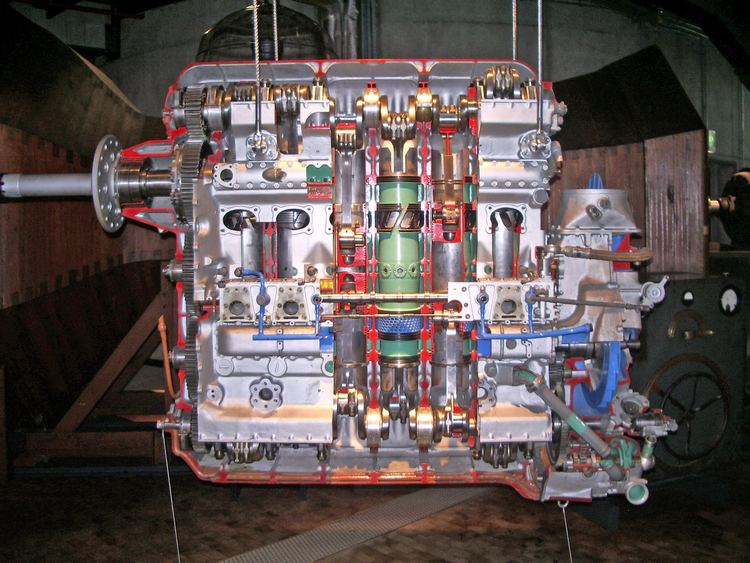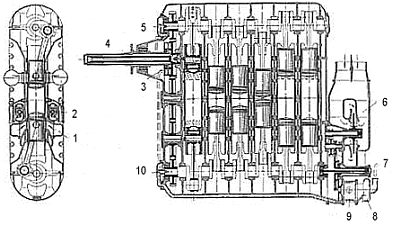Manufacturer Junkers | ||
 | ||
Junkers jumo 205
The Junkers Jumo 205 aircraft engine was the most famous of a series of aircraft diesel engines that were the first, and for more than half a century the only successful aviation diesel powerplants. The Jumo 204 first entered service in 1932. Later engines in the series were styled Jumo 206, Jumo 207 and Jumo 208, and differed in Stroke and Bore and supercharging arrangements. In all more than 900 of these engines were produced, in the 1930s and through most of World War II.
Contents
- Junkers jumo 205
- Opposed piston 2 stroke diesel engine animation junkers jumo 205 concept
- Design and development
- Variants
- Applications
- Applications list
- Specifications Jumo 205D
- General characteristics
- Components
- Performance
- Other notable opposed piston engines
- References

Opposed piston 2 stroke diesel engine animation junkers jumo 205 concept
Design and development

These engines all used a two-stroke cycle with twelve pistons sharing six cylinders, piston crown to piston crown in an opposed piston configuration. This unusual configuration required two crankshafts, one at the bottom of the cylinder block and the other at the top, geared together. The pistons moved towards each other during the operating cycle. Intake and exhaust manifolds were duplicated on both sides of the block. There were two cam-operated injection pumps per cylinder, each feeding two nozzles, for 4 nozzles per cylinder in all.

As is typical of two-stroke designs, the Jumos used fixed intake and exhaust port apertures cut into the cylinder liners instead of valves during their manufacture, which were uncovered when the pistons reached a certain point in their stroke. Normally such designs have poor volumetric efficiency because both ports open and close at the same time and are generally located across from each other in the cylinder. This leads to poor scavenging of the burnt charge, which is why valve-less two-strokes generally produce smoke and are inefficient.

The Jumo solved this problem to a very large degree through clever arrangement of the ports. The intake port was located under the "lower" piston, while the exhaust port was under the "upper". The lower crankshaft ran eleven degrees behind the upper, meaning that the exhaust ports opened and, even more importantly, closed first, allowing proper scavenging. This system made the two-stroke Jumos run as cleanly and almost as efficiently as four-stroke engines using valves, but with considerably less complexity.

There is some downside to this system as well. For one, since matching pistons were not closing at quite the same time, but one ran "ahead" of the other, the engine could not run as smoothly as a true opposed style engine. In addition, the power from the two opposing crankshafts had to be geared together, adding weight and complexity, a problem the design shared with H block engines.
In the Jumo, these problems were avoided to some degree by taking power primarily from the "upper" shaft, somewhat offset upwards on the engine's front end. All of the accessories, such as fuel pumps, injectors and the scavenging compressor, were run from the lower shaft, meaning over half of its power was already used up. What was left over was then geared to the upper shaft, which ran the engine's propeller. In all, about three-quarters of the power to the engine's propeller came from the upper crankshaft.
In theory, the flat layout of the engine could have allowed it to be installed inside the thick wings of larger aircraft, such as airliners and bombers. Details of the oil scavenging system suggest this was not possible and the engine had to be run "vertically", as it was on all designs using it.
Variants
A twelve-cylinder version, the Jumo 218, was designed but never built, while a single 24-cylinder 4-crankshaft Junkers Jumo 223 was built and tested.
The Jumo 204 and 205 were licensed to Napier, who built a small number as the Napier Culverin just prior to the war. After the war, they mounted three Culverins in a triangle layout to produce the Napier Deltic, which was for some time one of the most powerful and compact diesel engines in the world. Work on this engine started in 1947 and engines were running by 1950.
Applications
The Jumo 205 powered early versions of the Junkers Ju 86 bomber, but was found too unresponsive for combat and liable to failure at maximum power, common for combat aircraft. Later versions of the design also used the engine for extreme high-altitude use, as with the Ju 86P and -R versions for high-altitude reconnaissance over the British Isles. In January 1940, the Luftwaffe tested the prototype Ju 86P with the version Jumo 207A1 turbocharged diesel engines. It was far more successful as a power unit for airships, for which its characteristics were ideal, and for non-combat applications such as the Blohm & Voss Ha 139 airliner. Its more fuel-efficient operation lent itself for use on Germany's few maritime patrol flying boat designs during World War II, such as the Bv 138 and Bv 222.
Applications list
Specifications (Jumo 205D)
Data from
